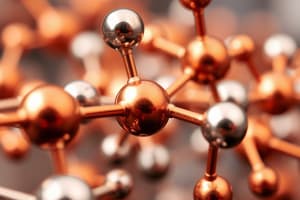Podcast
Questions and Answers
What is the molecular mass of N2?
What is the molecular mass of N2?
- 40 gm
- 50 gm
- 28 gm (correct)
- 32 gm
What is the value of R in the given reaction?
What is the value of R in the given reaction?
- 10 x 10^4
- 10 x 10^5
- 10 x 10^2
- 10 x 10^3 (correct)
What is the product of the reaction CO2 + 24 → 202?
What is the product of the reaction CO2 + 24 → 202?
- CO
- CHy (correct)
- CH4
- H2O
What is the value of n in the given equation?
What is the value of n in the given equation?
What is the formula mass of WHzo?
What is the formula mass of WHzo?
What is the amount of MNHz formed in the reaction?
What is the amount of MNHz formed in the reaction?
What is the molecular mass of Tryo?
What is the molecular mass of Tryo?
What is the value of the score in the given scorchiomety?
What is the value of the score in the given scorchiomety?
What is the formula mass of CO2?
What is the formula mass of CO2?
What is the amount of ecleti formed in the reaction?
What is the amount of ecleti formed in the reaction?
What does the symbol '>' represent in the content?
What does the symbol '>' represent in the content?
What is the charge of the Bez molecule?
What is the charge of the Bez molecule?
What is the difference between 'nunfanid' and 'infaiede'?
What is the difference between 'nunfanid' and 'infaiede'?
What is the significance of the numbers '17e' and '15e-' in the content?
What is the significance of the numbers '17e' and '15e-' in the content?
What is the chemical formula for the product formed when N2 reacts with O2?
What is the chemical formula for the product formed when N2 reacts with O2?
What is the significance of the phrase 'does not exist' in the content?
What is the significance of the phrase 'does not exist' in the content?
What is the value of the change in internal energy (Du) for a reversible process?
What is the value of the change in internal energy (Du) for a reversible process?
What is the formula used to calculate the work done (Win) in a reversible process?
What is the formula used to calculate the work done (Win) in a reversible process?
What is the value of the work done (Win) in the given example?
What is the value of the work done (Win) in the given example?
What is the formula used to calculate the work done (w) in an irreversible process?
What is the formula used to calculate the work done (w) in an irreversible process?
What is the value of the work done (w) in the given example, using the provided values?
What is the value of the work done (w) in the given example, using the provided values?
What is the relationship between enthalpy change (DH) and internal energy change (Du)?
What is the relationship between enthalpy change (DH) and internal energy change (Du)?
What is the value of the change in enthalpy (DH) in the given example, using the provided values?
What is the value of the change in enthalpy (DH) in the given example, using the provided values?
What is the formula used to calculate the change in internal energy (Du) for a process at constant volume?
What is the formula used to calculate the change in internal energy (Du) for a process at constant volume?
What is the equation represented for Ka in the content?
What is the equation represented for Ka in the content?
What does the equation x 10 represent in the content?
What does the equation x 10 represent in the content?
What is the value of C represented in the equations?
What is the value of C represented in the equations?
What is the relationship of Cry and Water in the content?
What is the relationship of Cry and Water in the content?
What is the formula for calculating DTb based on Ty and ty0?
What is the formula for calculating DTb based on Ty and ty0?
How is the term Pr interpreted in the content?
How is the term Pr interpreted in the content?
What does 3-2log2 equal in the provided equations?
What does 3-2log2 equal in the provided equations?
What value is assigned to Aly in the context provided?
What value is assigned to Aly in the context provided?
What multiplicative factor is used to convert Ty to DTb?
What multiplicative factor is used to convert Ty to DTb?
What is the numerical base used in the provided logarithmic expressions?
What is the numerical base used in the provided logarithmic expressions?
Which operation is primarily shown in the expression 10-7?
Which operation is primarily shown in the expression 10-7?
In the expression Ty = 354 11k - 0.88, what operation is primarily being carried out?
In the expression Ty = 354 11k - 0.88, what operation is primarily being carried out?
What is the significance of the expression '2057X 163' in relation to C?
What is the significance of the expression '2057X 163' in relation to C?
What components are involved in the equation that includes DTb?
What components are involved in the equation that includes DTb?
Flashcards
What is a mole?
What is a mole?
The amount of a substance containing the same number of particles as there are atoms in 12 grams of carbon-12.
What is stoichiometry?
What is stoichiometry?
The quantitative relationship between reactants and products in a chemical reaction.
What is molar mass?
What is molar mass?
The mass of one mole of a substance, usually expressed in grams per mole (g/mol).
What is molar volume (at STP)?
What is molar volume (at STP)?
Signup and view all the flashcards
What is Dalton's Law of Partial Pressures?
What is Dalton's Law of Partial Pressures?
Signup and view all the flashcards
What is ΔU = nCvΔT?
What is ΔU = nCvΔT?
Signup and view all the flashcards
What is the equilibrium constant (K)?
What is the equilibrium constant (K)?
Signup and view all the flashcards
What is Le Chatelier's Principle?
What is Le Chatelier's Principle?
Signup and view all the flashcards
What is the acid dissociation constant (Ka)?
What is the acid dissociation constant (Ka)?
Signup and view all the flashcards
What is pH?
What is pH?
Signup and view all the flashcards
What is dilution?
What is dilution?
Signup and view all the flashcards
What is the dilution equation?
What is the dilution equation?
Signup and view all the flashcards
What is Molarity?
What is Molarity?
Signup and view all the flashcards
What is ionic strength?
What is ionic strength?
Signup and view all the flashcards
What are activity coefficients?
What are activity coefficients?
Signup and view all the flashcards
How does temperature affect reaction rates?
How does temperature affect reaction rates?
Signup and view all the flashcards
What is the rate-determining step?
What is the rate-determining step?
Signup and view all the flashcards
What are standard electrode potentials?
What are standard electrode potentials?
Signup and view all the flashcards
What is the Nernst equation?
What is the Nernst equation?
Signup and view all the flashcards
What is the universal gas constant (R)?
What is the universal gas constant (R)?
Signup and view all the flashcards
What is Avogadro's number?
What is Avogadro's number?
Signup and view all the flashcards
Why practice unit conversions?
Why practice unit conversions?
Signup and view all the flashcards
What is a limiting reactant calculation?
What is a limiting reactant calculation?
Signup and view all the flashcards
What is enthalpy change (ΔH)?
What is enthalpy change (ΔH)?
Signup and view all the flashcards
What is entropy?
What is entropy?
Signup and view all the flashcards
What is Gibbs free energy?
What is Gibbs free energy?
Signup and view all the flashcards
What is chemical kinetics?
What is chemical kinetics?
Signup and view all the flashcards
What is a reaction mechanism?
What is a reaction mechanism?
Signup and view all the flashcards
What is a catalyst?
What is a catalyst?
Signup and view all the flashcards
What is activation energy?
What is activation energy?
Signup and view all the flashcards
Study Notes
Chemical Calculations and Formulas
- Essential calculations are performed using moles and mass, e.g., 2 moles of H₂O = 36 g.
- Application of stoichiometry is crucial in balancing reactions and determining reactant/product relationships.
- Converting moles to grams involves multiplication by molar mass, which is vital in quantitative chemistry.
Gases and Molar Volumes
- The molar volume of gases is vital in calculations, often approximating to 22.4 L for ideal gases under STP conditions.
- Issues of partial pressures can be addressed using Dalton's Law, which states that the total pressure is the sum of individual pressures in a mixture.
Thermodynamics and Energy
- The relationship between enthalpy change (ΔH) and temperature can be modeled, with calculations involving the gas constant R.
- Key equation: ΔU = nC_vΔT, where ΔU is the change in internal energy, n is the number of moles, C_v is the molar heat capacity at constant volume, and ΔT is the temperature change.
Equilibrium and Reaction Quotients
- Equilibrium constants (K) are determined for reactions; they indicate the extent of a reaction at equilibrium.
- Le Chatelier’s Principle describes how a system at equilibrium responds to stress (changes in concentration, temperature, or pressure).
Acid-Base Chemistry
- Acid dissociation constant (Ka) indicates the strength of an acid in solution; it is crucial for understanding pH levels.
- The relationship between pH and hydrogen ion concentration is given by the formula pH = -log[H⁺].
Concentrations and Dilutions
- Dilution calculations utilize the equation C₁V₁ = C₂V₂, where C is concentration and V is volume.
- Understanding molarity (moles per liter) is essential when preparing solutions for reactions.
Ionic Strength and Activity
- Ionic strength affects the behavior of ions in solution and must be calculated to correctly interpret reaction environments.
- Activity coefficients adjust for non-ideal behavior in concentrated solutions.
Reaction Mechanisms and Rates
- Reaction rates can be adjusted by changing concentration or temperature, highlighting the importance of activation energy.
- Understanding the mechanism involves breaking down steps of reaction to identify rate-determining steps.
Electrochemistry
- Standard electrode potentials indicate the tendency of a species to be reduced or oxidized.
- The Nernst equation is used to calculate cell potential under non-standard conditions: E = E° - (RT/nF)lnQ.
Key Units and Constants
- Familiarity with key constants such as the universal gas constant (R = 8.314 J/(mol·K)) and Avogadro's number (6.022 × 10²³) is critical.
- Unit conversions (e.g., atm to kPa) must be practiced for precision in calculations.
Studying That Suits You
Use AI to generate personalized quizzes and flashcards to suit your learning preferences.




